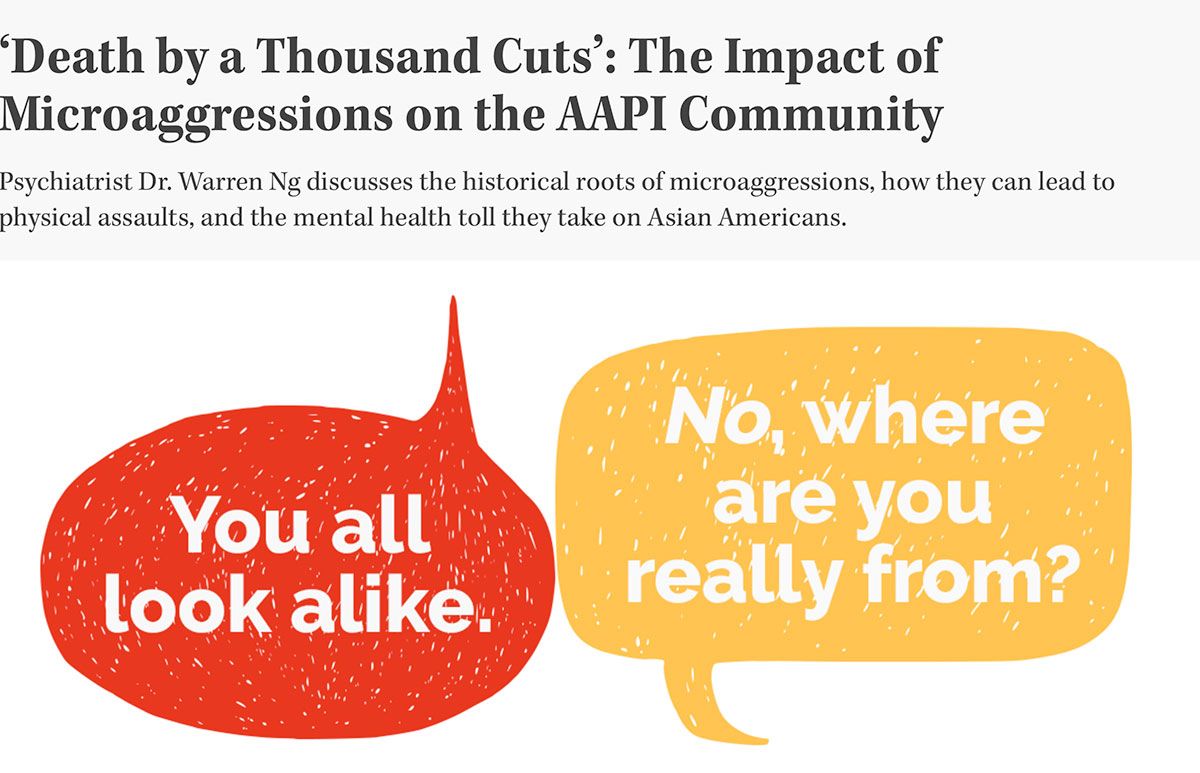Death by a Thousand Cuts

What are the historical roots of microaggressions against Asian Americans? In this important article, published in “Health Matters,” psychiatrist Dr. Warren Ng lays out what microaggressions are and what its history is.
The article is, unfortunately, timely because there has been a tragic
surge in anti-Asian sentiment across the US. Hate crimes against Asian
Americans and Pacific Islanders (AAPI) in cities across the nation have
increased 169% in the first quarter of 2021 over the same period in
2020, according to a recent analysis by the Center for the Study of Hate
and Extremism at California State University, San Bernardino. These
incidents are in the media but the AAPI community has experienced
violent racism as well as microaggressions for years, in fact, for
hundreds of years.
The article mentions “Derald Wing Sue, M.S., Ph.D., a professor of
psychology and education at Teachers College, Columbia University, whose
books and research have focused on race, defines microaggressions as
slights and invalidations that people of color experience in their
day-to-day interactions with well-intentioned individuals.
Microaggressions aimed at AAPIs (such as asking “Where are you really
from?” or commenting “You speak English so well.”) are largely
manifestations of harmful stereotypes that consistently view Asian
Americans as perpetual foreigners, the model minority, and the yellow
peril — the belief that Asians (particularly East Asians) pose a danger
to Western values, power, and culture.”
And continues with, “Microaggressions are really meant to make people
feel like lesser human beings,” says Dr. Warren Ng, medical director of
outpatient health at NewYork-Presbyterian/Columbia University Irving
Medical Center and director of clinical services for the Division of
Child and Adolescent Psychiatry at NewYork-Presbyterian Morgan Stanley
Children’s Hospital. ‘There’s another term for microaggressions: Death
by a thousand cuts. I think that description really does speak to the
cumulative effects.’”
Disarming Microaggressions is SunShower’s newest e-Learning course.
It is the result of a collaboration with Dr. Derald Wing Sue and
teaches his strategies for speaking up and interrupting or countering
microaggressions in the moment or afterwards.
Dr. Ng starts with what he calls the root of it all, “the yellow
peril stereotype”. The idea was that Asians were taking away
opportunities from “real” Americans who were already there. In order to
keep them in their place, laws were enacted to take away their freedoms,
rights and families. Dr. Ng mentions the internment of Japanese
Americans during WWII, the murder of Vincent Chin, post-9/11
scapegoating of Muslim Americans, and other instances.
And today, through the pandemic, it continues. “We’ve felt a
universal sense of loss, mourning, and stress during this period of
COVID-19. The question is “What do you do with those feelings, and that
discomfort, and that difficulty?” You can choose to see it as something
that we as a human race are all going through. Or you can try to blame
someone for it. Through scapegoating, you find a target and then
dehumanize them, which allows you to remove your emotions and your
feelings from your actions, because you almost feel justified.
It’s happened repeatedly throughout history. How does something as
little as name calling lead to something like murder? That seems like a
big jump. But there’s a pathway to that action and understanding where
microaggressions, racism, dehumanization, objectification, stereotyping,
and all of those things lead to us distancing ourselves and our
humanity from that other person who is a human being. The more that they
are not a human being, the more that we’re able to feel that we can do
things to them because they’re not the same as you and I.”
We recommend you read the entire article and then Test Drive our
course, Disarming Microaggressions with Dr. Derald Wing Sue. It’s won
awards and been recognized as an excellent resource.
Lastly, Dr Ng shares, “How To Be an Ally: 10 Ways a Non-AAPI Person Can Champion Justice and Help Combat Microaggressions:
- Do the work by reading about the history of racism and microaggressions.
- Do the work by reading about the history of racism and microaggressions.
- Reach out and listen to the experiences of people of color or marginalized groups.
- Get comfortable being uncomfortable because that is a sign that you are doing the work. Accepting the status quo can trap you into being a part of discriminatory systems.
- Practice compassion for yourself because a lot of the work will be making mistakes and continuing to learn new skills of allyship — and unlearning behaviors that perpetuate microaggressions.
- Work to change perceptions by acknowledging your own implicit bias and where you may lack awareness.
- Work to change behaviors and speak up in your own circles when you hear microaggressions or derogatory language.
- Join inclusion groups to get out of an echo chamber. Surround yourself with people who share different life experiences and who can also learn from yours.
- Take a course in bystander training so you’re better equipped to respond to racist incidents. The Hollaback! training encourages the use of the 5 Ds: distract, delegate, delay, direct, and document. The information can be found here.
- Sponsor members of marginalized groups who are underrepresented. This may be supporting an AAPI peer or co-worker and advocating for them to reach management or senior levels — positions that are often limited to people of the majority race.
- Read the Guide to Allyship.”

